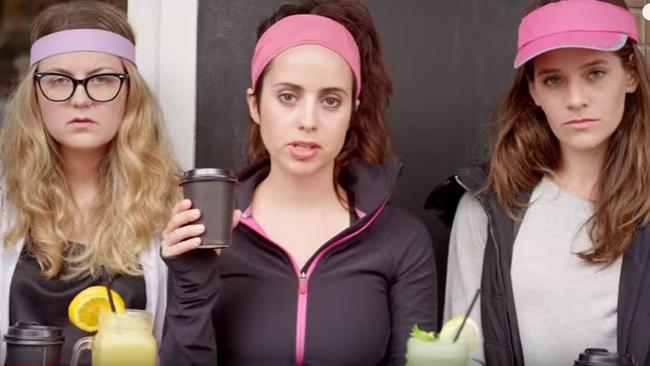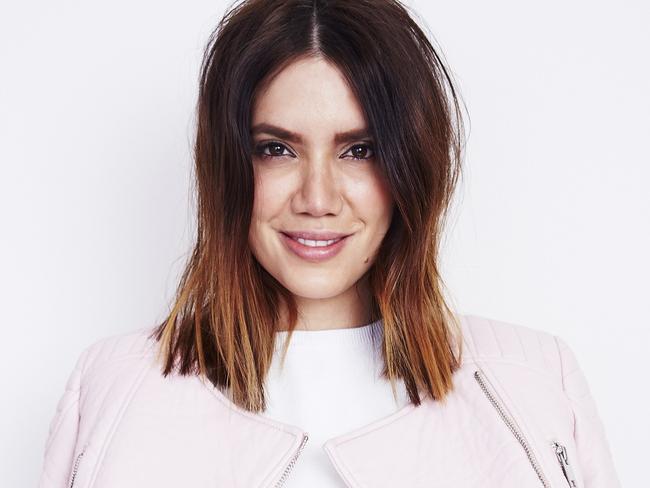Meet the woman to blame for one of fashion’s most divisive trends: activewear
IT’S THE uniform of yoga mums, uni students and latte sippers in capital cities across Australia. But has activewear finally reached its peak?

IT’S THE uniform of yoga mums, uni students and latte sippers in capital cities across Australia.
Activewear is the fashion trend that gets under the skin of those who don’t subscribe to its expensive, skin tight and unexpectedly versatile aesthetic.
Shamelessly worn at every possible opportunity, regardless of whether one actually partakes in physical exercise, activewear evokes a strong reaction in those who cross its path.
Patterned tights worn as pants, white runners that magically seem to never get dirty and crop tops galore, you either love this look, or hate it with a passion. Or, as comedic duo Christiaan Van Vuuren and Nicholas Boshier opted to do, send it up.
The pair known as the Bondi Hipsters last year created a viral parody video of young, Lycra-clad women performing tasks ranging from grocery shopping and waiting for the bus to putting the bins out, getting manicures, drinking coffee and smoking cigarettes. Oh, and huffing and puffing after performing the slightest bit of exercise.
It received more than four million views on YouTube and prompted comments like “Literally 95 per cent of the women in my city” and “Funny cos it’s true, especially in Sydney’s Eastern burbs!”
Ironically, even Van Vuuren and Boshier are cashing in; you can buy one of their singlets, emblazoned with the message “literally doing nothing in my activewear”, for $34.
THE ACTIVEWEAR QUEEN

The woman who has done more than perhaps any other Australian to push activewear’s ascendancy is Julie Stevanja.
Stevanja, who founded Stylerunner.com with her sister in 2012, was named Young Retail Entrepreneur of the Year at the World Retail Awards last month, after the eCommerce start-up was listed on the Deloitte Tech Fast 50 Rising Star and BRW Fast Starters List.
Stevanja not only jumped on the activewear trend early, but she’s heavily invested in keeping it going.
But will Australians remain willing to pay top dollar for items designed to be sweated in?
By definition, all fashion trends must come to an end, but Stevanja insists that the activewear craze is part of a “lifestyle shift” that shows no signs of abating.
HAS ACTIVEWEAR PEAKED?
While the category is expected to continue growing, some analysts believe it has already reached its peak.
An Ibis World report published last month said that while the $81.4 million online activewear industry “has been kicking goals over the past five years”, demand for up-market sporting apparel was set to slow down.
“Industry growth potential is expected to continue shrinking over the next five years, as fashion trends move away from wearing sporting apparel for non-exercise purposes and as the take-up of online shopping begins to slow,” the report said.
Demand for up-market sporting apparel was “nearing its peak”, the report said, forecasting that the 20.1 per cent growth of the last five years would slow to an annualised 8.2 per cent over the next five years, with revenue set to reach $120.6 million in 2020-21.
That’s still a hell of a lot of cash to be carved up among key players in what is a largely fractured market.
Small operators like Stylerunner lay claim to 64.1 per cent of online activewear sales, while Lorna Jane owns the biggest stake, 26.4 per cent. Rebel and Amart parent company Super Retail Group is the second largest player with 9.5 per cent.

For Stylerunner, leveraging a strong social media presence, including almost half a million Instagram followers, is key.
The company aims to play a similar role to that traditionally played by fashion magazines in shaping what women choose to wear.
“One of the key differences is the attention that we put into styling the product,” Stevanja said.
“The effort we put into hair and make up, the photography, it’s really about styling and inspiring ... We want customers to come to our site and find products that we’ve obviously endorsed, so we curate the brands that we bring on. Anything you find on Stylerunner has our tick of approval.”
Premium labels like Lululemon and Stella McCartney are featured alongside emerging labels and celebrity collaborations like Puma x Rhianna, with an emphasis on fashion and style. Deliveries come wrapped in tissue paper with an inspiration quote nestled inside.
Staff not only “curate” high-end workout gear, but also proactively influence suppliers’ product lines, Stevanja told news.com.au.
“We actually say ‘hey, we have this idea for a product, could you design and make it for us because we think it would be next level and our customers would love it’,” she said.
As far as Stevanja is concerned, activewear is here to stay.
Her response to the Bondi Hipsters: “They can laugh, but I think they’ve got to get used to the fact it’s going to be around for quite a while.”
Of their YouTube sketch, she said, “My first reaction was ‘not sure if I should be laughing or crying’ ... But that’s when you know the industry’s really made a mark.”




